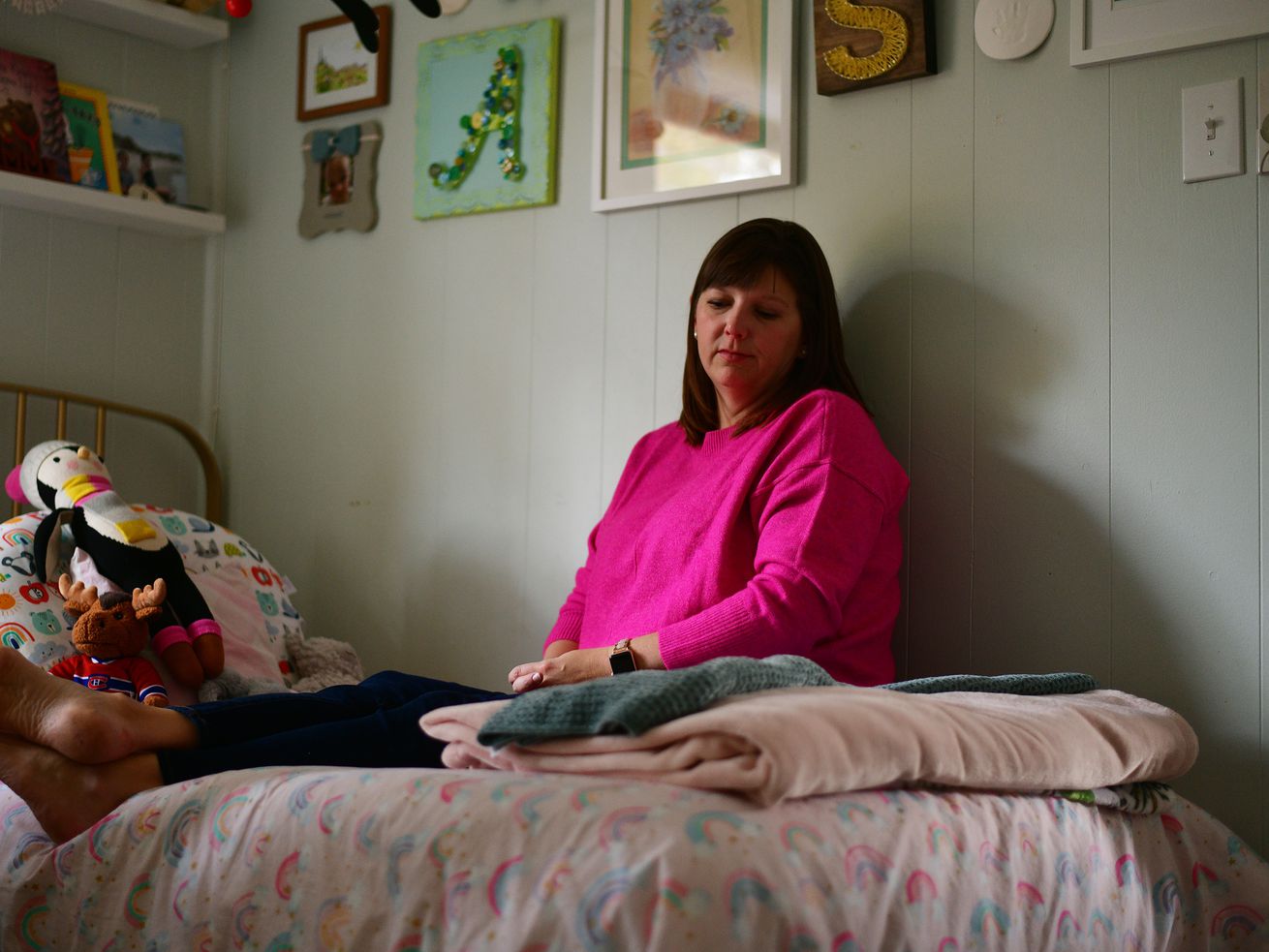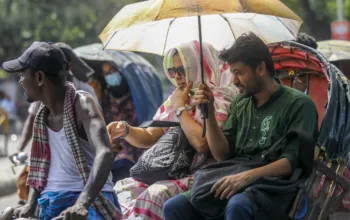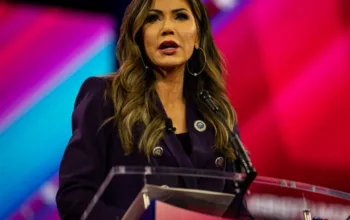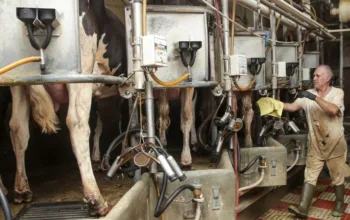Large vehicles and unsafe streets are killing too many people, including 5-year-old Allison Hart. Now her mother is fighting for safer streets.
How do you commemorate the life of a 5-year-old girl?
Here is what it looks like on one street corner in Washington, DC: a tiny bicycle, painted all in white, with a little wicker basket filled with purple and white silk flowers on the handlebars. A teddy bear in a princess dress sits on the seat, and on the ground nearby, a pile of stuffed animals — monkeys and puppies and lambs and bears and elephants — turn gray from exposure to the elements.
The intersection looks like so many of the four-stop crossings on so many roads all over the country, except for this memorial. It marks the place where, in September 2021, Allison Hart was killed while riding her bike.
/cdn.vox-cdn.com/uploads/chorus_asset/file/24209833/Allison21.jpg)
Eight months later, on a humid Wednesday afternoon in May, Allie’s mom, Jessica Hart, places her 3-month-old son in a black stroller. She pushes open the gate to the fence outside her home, a cream-colored bungalow surrounded by wide streets and well-manicured lawns in a neighborhood that appears transported from the suburbs. A longhaired cat sits watching her from the screened-in porch as she maneuvers the stroller onto the sidewalk.
“We don’t really come this way ever,” Jessica says, walking the block up the street to where her daughter was killed. She’s wearing a striped linen shirt with jeans and pink sandals, which match her pink nails — Allie’s favorite color. A small “A” charm dangles from her neck. As she approaches the memorial, she comes to a stop and takes in the scene, a pair of Ray-Bans shading her eyes from the sun.
Allie was with her dad, Bryan, in the crosswalk when she was struck by the driver of a van. She was one of 20 pedestrians and cyclists killed in Washington, DC, in 2021. Another child, 4-year-old Zy’aire Joshua, was killed in Northwest DC as he crossed the street with his mom. Adults were killed, too: a 47-year-old bike courier and father of three named Armando Martinez-Ramos; a 24-year-old aspiring opera singer named Nina Larson; two advocates for DC’s homeless population, Waldon Adams and Rhonda Whitaker; a PhD student named Jim Pagels. In 2022, three US diplomats were among those killed in the region.
Across the country, more pedestrians were killed in 2021 than at any time in the past 40 years, according to data from the Governors Highway Safety Association. But the pandemic years aren’t outliers — pedestrian deaths have been rising for more than a decade. Between 2010 and 2020, they rose by 54 percent. Among cyclists, they rose 50 percent. Contained within the statistics are countless human tragedies, like the Harts’.
Allie’s obituary told of a little girl who “loved deeply and laughed often,” who aspired to be a “rock scientist,” who was fascinated by Brood X cicadas and Legos and American Girl dolls. At the memorial, her classmates showed up and blew bubbles in her honor. In the early days after she died, there was almost nothing that could ease Jessica and Bryan’s heartbreak. But sharing their memories of their little girl with others, and their outrage at her death in a place she should have been safe, that felt important. “I just wanted to share her with people. At some point, I think, I felt so helpless because I couldn’t save her or protect her,” Jessica says. She pushes the stroller, and her voice begins to break. “It’s just a nightmare, but also it’s just like, my daughter dies, and nothing changes. How could that be?”
She thinks about the parents of Newtown, Connecticut, who lost their children and then watched the Senate vote down a bipartisan gun reform bill a few months later. How do they live with this? How does she?
“So many people die every year because of cars, and nothing changes,” she says. Which can make her new mission — pushing for safer cars and streets so that no one has to go through what she and Bryan did — feel, as she describes it, “like a futile endeavor.” Still, she can’t accept the idea that it’s hopeless. “It won’t bring her back,” she says. “But I just can’t let it go.”
/cdn.vox-cdn.com/uploads/chorus_asset/file/24244408/IMG_9244a.jpg)
Courtesy of Jessica Hart
At the beginning of the pandemic, Jessica started taking a photo of Allie each day. It was a way to document how they spent a historic time, when life changed overnight. The photographs ended up being incredibly important, a document of what would become a significant portion of their daughter’s life, up until its final day. Jessica thought she would have the photo books printed for her daughter, but they didn’t show up until after she died.
So much is contained in the photo albums: Allie on a family beach vacation, in a swimsuit adorned with cherries, jumping in the surf. Allie bouncing on the bed, her hips and hair twisting in different directions, the embodiment of joy. Allie twirling in a lavender leotard, eyes focused on her Zoom ballet class. Allie crouching in front of a puddle, wearing a raincoat with floppy ears, making mud soup for the fairies.
It surprised Jessica, when Allie was born, how much she loved being a mom. She always knew she wanted children, but she was awed by the tactile intimacy of it, how life-affirming it felt to care for this little girl, a love greater than anything she’d ever imagined. All of the small delights of being Allie’s mother, how she loved to be wrapped up in a towel and held like a baby after her bath, even as she was getting to be 40 pounds. Sometimes the grief is an absence of her weight — the knowledge that she’ll never hold Allie in her arms again.
Jessica and Bryan were expecting their second child when Allie died. “Being pregnant when she died saved me,” Jessica says. “Those months between when she died and he was born were just … awful.” Often, the grief lives at the back of her throat. It is palpable, a wound she would never want to heal. “You have a child for five years, and then suddenly, you don’t.” She remembers thinking: “What do I do with myself?”
/cdn.vox-cdn.com/uploads/chorus_asset/file/24210365/Allison15.jpg)
/cdn.vox-cdn.com/uploads/chorus_asset/file/24210553/Allison02.jpg)
/cdn.vox-cdn.com/uploads/chorus_asset/file/24244556/Allison14.jpg)
Soon, they discovered, there were others who shared their grief, including the artists who organized an event closing off the street so children and adults could take over the intersection, writing “SAFE STREETS” in chalk and drawing colorful tributes to Allie on the pavement. Jessica also heard from — and reached out to — other parents who’d lost loved ones, including Amy Cohen, whose son, Sammy Cohen Eckstein, was killed by a van driver in New York City in 2013.
“After he died, I felt like I had to fight for him and make sure this didn’t happen to anyone else,” Cohen says. Before long, she was standing on her street with a radar gun, clocking the vehicles speeding down her street. (Speed is a major factor in pedestrian deaths; the faster a vehicle is going, the more likely it is to fatally injure a pedestrian it strikes.) She encountered Sen. Chuck Schumer, who lived in a neighboring building, and begged him to do something about rampant speeding on city streets. She began speaking out at rallies and connected with Transportation Alternatives, a New York-based group that advocates for policies that make roads less dangerous, who helped Cohen start an organization called Families for Safe Streets.
At the time, there wasn’t a national organization on the scale of Mothers Against Drunk Driving that included the broader spectrum of loved ones who’ve lost family members to traffic violence. “We thought, how can there not be something for this huge, preventable crisis that we have?” Cohen says. Their first campaign involved lobbying the state legislature in Albany to allow New York City to lower the default speed limit on city streets to 25 miles per hour — it became law in 2014. Cohen and her family members went to the statehouse with photos of Sammy and handed them out to legislators. Getting the speed limit reduced was difficult, and Cohen says no victory has come as easily since. “I’ve come to learn, painfully, that change is slow,” she says. “But we have seen that our voices can make a huge difference.” The group has since started local chapters across the United States.
The day after Allie was killed, the father of one of her schoolmates posted a video on Twitter of a driver swerving into oncoming traffic so he could bypass the driver in front of him and blow through the intersection without stopping. Jessica also started standing out at the intersection, capturing drivers rolling through the stop and posting it online.
Twitter became a space for Jessica to share her love for Allie, her heartbreak, and her rage at a society that treats high levels of road deaths as part of the normal order of things. There, she found a community of people who validated her sense that something was deeply wrong. She tagged local officials, applauding when they added flexible posts that can help guide and slow traffic, and demanding to know when they would add speed bumps. That November, two months after Allie died, she testified for the first time in front of a city council committee, demanding more speed cameras, safety upgrades, and consequences for drivers who violated traffic laws. In her own way, she became one of the city’s most visible advocates for safe streets: a mother who could speak with force and clarity about the devastation wrought by the crisis.
“I think maybe it helps people to have a face or a story or a family,” she says of her decision to speak out. “Being only 5, part of it is having anybody remember her —” she pauses to collect herself, “It’s a gift. So it’s hard. But it’s the least hard of all the hard things.”
/cdn.vox-cdn.com/uploads/chorus_asset/file/24210717/Allison10.jpg)
Allie’s death came amid a major transformation on US roads, spurred by the kinds of vehicles Americans drive. SUVs and trucks are getting bigger, and Americans are buying more of them every year. Between 2000 and 2019, the number of sedans and other small vehicles on the road dropped from over 60 percent to around 40 percent of all vehicles, according to an analysis by Justin Tyndall, assistant professor of economics at the University of Hawaii. The number of SUVs increased from 10 percent to more than 30 percent. And the appetite for larger vehicles isn’t slowing down: In October 2021, according to the consumer research firm JD Power, trucks and SUVs made up over 80 percent of all new vehicle sales.
Poorly designed infrastructure is one of the main reasons the United States has a traffic fatality rate that is about 50 percent higher than other comparable nations: Wide roads and a lack of designs that force drivers to slow down encourage them to drive recklessly, without providing safe options for pedestrians and cyclists. But vehicle design is also a key component of the pedestrian fatality crisis, and it’s one that researchers have known about for decades.
Sales of SUVs started to pick up in the late ’90s and early 2000s, as Americans started spending money on larger, more spacious vehicles. In 2001, two researchers at Rowan University calculated pedestrian fatality data to determine how much more dangerous large vehicles were than their smaller counterparts. Their findings were striking: With smaller cars, one out of 20 collisions involving a pedestrian caused the pedestrian’s death; with large SUVs, it was one in seven. With large vans, it was one in four. The authors, Devon Lefler and Hampton Gabler, pointed to multiple factors that explained the heightened risk. Larger vehicles, they wrote, “are heavier, stiffer, and geometrically more blunt than passenger cars.”
The heavier vehicles gather more power with speed, increasing the force with which they strike a body. Unlike cars, which tend to be lower to the ground and strike pedestrians in the legs, the heightened front ends of large vehicles mean that they strike pedestrians in the chest and head, putting them at greater risk of fatal injuries. In 2010, a different group of researchers found that pedestrians struck by light trucks (a vehicle classification that includes pickup trucks, some vans, and SUVs) were 50 percent more likely to die than those hit by sedans and other smaller cars. Larger vehicles also have significantly larger blind spots, making it harder to see pedestrians, especially when they’re children.
/cdn.vox-cdn.com/uploads/chorus_asset/file/24248159/copyedited_121.jpg)
“We’ve known for decades that larger vehicles are more dangerous in pedestrian crashes,” says Robert Schneider, a University of Wisconsin-Milwaukee professor of urban planning who analyzed government crash data. He found that while child fatalities significantly decreased between 1977 and 2016 (likely attributable to the declining share of children who walked to school), fatalities involving large vehicles had increased from 22 percent to 44 percent. “It’s been very unfortunate to not have a more serious regulation on vehicle size and front-end design that could be much safer for pedestrians,” he says.
Last year, Tyndall, the professor at the University of Hawaii, analyzed the pedestrian fatality rate across different metropolitan areas from 2000 to 2019. The idea was to look at the growth rate of large vehicles as a share of the vehicle fleet in different cities, and look at the pedestrian fatality rates in those same areas. The cities with a sharp increase of SUVs, he found, saw a significant increase in pedestrian deaths. “DC stood out,” along with other cities in the region, Tyndall says, because there was “a big shift away from cars in Midwest and Northeast cities and toward SUVs and trucks — it explains some of the change in pedestrian death rate in the areas over this 20-year period.”
Experts have for years been urging the agency to consider pedestrian safety when rating vehicles. In March 2022, the National Highway Traffic Safety Administration proposed changing the safety ratings the government gives to vehicles to consider how they impact people outside of cars in crashes. On the public comment page for the proposed rule change, safety advocates inundated the comments section, encouraging the government to take action.
The failure to meaningfully regulate vehicle design runs deep, according to research by John Saylor. In an academic article published in May 2021, “The Road to Transportation Justice: Reframing Auto Safety in the SUV Age,” Saylor, then a doctoral candidate at Penn Law, reviewed documents from the agency that revealed they had tried to pass safety regulations considering pedestrian safety several times and were hamstrung by federal policymakers who viewed safety regulation primarily through the viewpoint of consumer protection. In other words, the safety regulations were designed with the auto buyer in mind, at the expense of all others. The age of the SUV, he argued, requires us to dramatically reimagine what it means to regulate the safety of vehicles.
/cdn.vox-cdn.com/uploads/chorus_asset/file/24244339/chart1130.jpg)
In response to questions about criticism that the agency hasn’t moved fast enough to regulate vehicle size and design, NHTSA’s director of media relations, Lucia Sanchez, told Vox in a statement that “advancing safety for vulnerable road users like pedestrians is a priority for the agency and eliminating these fatalities is critical. The Department believes that no crash is acceptable and is working cross functionally, guided by the National Roadway Safety Strategy, to reduce crashes and along with them, serious injuries and fatalities.” Sanchez pointed to a new rule to mandate pedestrian automated emergency braking in new vehicles, and recent proposed changes to the government’s five-star safety ratings for cars.
There’s good reason for the government to act now, Tyndall says. If the current sales trends don’t change, larger vehicles will become an ever-increasing share of all vehicles on the road.
“It’s already sort of baked in that it’s going to get way worse, depending on how long that trend is allowed to continue,” he says.
Here’s another tribute to Allison Hart: It’s October, and Jessica is standing in front of a maple tree on her block, its leaves turned crimson. Above her, a slice of moon is just visible in a clear blue sky. A few weeks ago, she went door-to-door in her neighborhood with flyers, asking neighbors to join her and Bryan in cleaning up their block and the one adjacent to it, which they’d adopted from the city in Allie’s memory.
It had been a long season — their first summer without Allie. They felt her absence on what should have been her sixth birthday, when they couldn’t think of anything they wanted to do except leave town. They felt it during the summer beach trip with Jessica’s parents in South Carolina, where they imagined Allie swimming in the pool on her own for the first time, and marching up to other little kids and asking them if they wanted to play. “It was so noticeable,” Jessica says.
In September, on the anniversary of Allie’s death, the family rented a cabin in the Shenandoah Valley. The previous summer, they’d driven past the Luray Caverns with Allie and promised her they’d go another time, taking for granted that there would be another time. Jessica thought of how Allie would have loved it, how she would have delighted in explaining the difference between stalactites and stalagmites, how she would have begged for a rock from the gift shop. She remembers looking out over the valley and thinking: “How can this whole world be out here and my daughter is gone?”
While they were out of town, local news outlets covered the anniversary of Allie’s death, and two neighborhood representatives organized a campaign where local residents filed safety requests to the city with the hashtag #All4Allie.
Jessica is navigating what it’s like to be both a grieving mother and the mother of a baby. She and Bryan are determined not to let Allie’s death be shrugged off as another unfortunate but unavoidable tragedy, and are dedicated to honoring their daughter’s memory in any way they can think of. It’s a small thing, this neighborhood beautification effort, but it feels like useful work. “I remember once she told me, ’Mommy, I hate litter!’” Jessica says, stamping her foot and channeling Allie’s frustrated voice.
At first, it’s just Jessica and Bryan out there, using rakes to loosen leaves stuck in the curbs and picking up trash from the sidewalk. Soon, other neighbors come out with their children, picking up rakes and gathering leaves. People wave and say hello, and Jessica feels encouraged. They remembered.
/cdn.vox-cdn.com/uploads/chorus_asset/file/24210745/ARD_7009.jpg)
/cdn.vox-cdn.com/uploads/chorus_asset/file/24210592/Allison23.jpg)
A block away, the monument to Allie has weathered another season. The fur of the stuffed animals is matted and shiny after a summer of rain. A pail that held nubs of colorful chalk is now full of rainwater. But there’s something new there, too: a photo collage of pictures of Allie, covered in plastic, hanging from a utility pole. Jessica put it there.
Part of what’s so frustrating to her is that the solutions that could save lives — making streets and vehicles safer, and finding ways to get drivers to slow down — are already known. It’s hard to know what exactly to do when your little girl is killed in a way that so many others are each year, and when everyone continues to move on with their lives as though everything is normal. It will never be normal for Jessica. She isn’t a professional activist. Still, she’s committed to doing whatever she can to make sure Allie isn’t forgotten and that the crisis of road deaths isn’t ignored anymore.
Later that day, she’ll post a photo on Twitter of all the leaves and trash collected by her and her neighbors beneath one of the street dedication signs for Allie. In another tweet, she shares the sign, along with a tribute: “Put my girl’s name everywhere. Shout it to the rooftops. Remember her bright, joyful being. Know that she is one of too many. Fight for change.”
/cdn.vox-cdn.com/uploads/chorus_asset/file/24210720/Allison22.jpg)
Author: Marin Cogan
Read More



